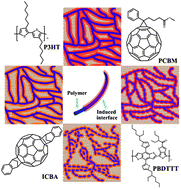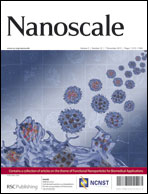A material combination principle for highly efficient polymer solar cells investigated by mesoscopic phase heterogeneity†
Abstract
Organic solar cells have become a promising energy conversion candidate because of their unique advantages. Novel fullerene derivatives, as a common acceptor, can increase power conversion efficiency (PCE) by increasing the open-circuit voltage. As a representative acceptor, Indene-C60 bisadduct (ICBA) can reach high efficiency with poly(3-hexylthiophene) (P3HT). On the other hand, the novel synthesized polymers mainly aimed to broaden the optical absorption range have steadily promoted efficiency to higher than 9%. However, it is challenging to obtain the desired result by simply combining ICBA with other high-efficiency donors. Thus, P3HT or a high-efficiency polymer PBDTTT-C-T (copolymer of thienyl-substituted BDT with substituted TT) is used as donor and PCBM or ICBA as acceptor in this article to clarify the mechanism behind these materials. The optical and photovoltaic properties of the materials are studied for pair-wise combination. Among these four material groups, the highest PCE of 6.2% is obtained for the PBDTTT-C-T/PCBM combination while the lowest PCE of 3.5% is obtained for the PBDTTT-C-T/ICBA combination. The impact of the mesoscopic heterogeneity on the local mesoscopic photoelectric properties is identified by photo-conductive AFM (pc-AFM), and the consistence between the mesoscopic properties and the macroscopic device performances is also observed. Based on these results, an interface combined model is proposed based on the mesoscopic phase heterogeneity. This study provides a new view on the rational selection of photovoltaic materials, where, aside from the traditional energy level and absorption spectrum matching, the matching of mesoscopic heterogeneity must also be considered.


 Please wait while we load your content...
Please wait while we load your content...